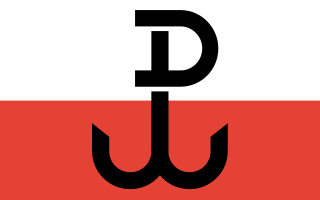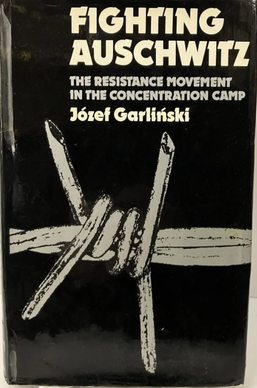

The National Memorial Arboretum near Lichfield, Staffordshire, England, comprises 150 acres of woodland and memorials dedicated to the fallen servicemen and women from World War I, World War II and other conflicts of the 20th Century.
Until this monument, there was none in Britain to all Poles across Europe who died during World War II. Polish Forces served with the Allies from the first day of war until the last, fielding for instance the fourth-largest Allied army in the fight against Nazi German tyranny across Europe. Poles gave their lives on all fronts – on land, at sea and in the air – where they distinguished themselves with courage and self-sacrifice. [1] Many were stationed in Britain. A prominent memorial in Cardiff commemorates all Polish soldiers, sailors and airmen who died in the war.
Four humble toy soldiers, each painted bronze and glued back-to-back atop a two-pence piece, created by Dr. Andrzej Meeson-Kielanowski, provided the inspiration behind the monument's design. It was decided that the statue design would be based on the concept and would comprise four sculptures of typical members of the main branches of the Polish Armed Forces: the Air Force, the Army, the Navy and the Polish Underground Home Army. The airman is a Polish pilot from RAF 303 Squadron during the Battle of Britain; the Underground figure is a woman courier wearing civilian clothes; the army is represented by a typical Polish soldier from the battle of Monte-Cassino; the seaman is a crew member of the Polish destroyer Błyskawica. In addition, the figures are ‘combined’ with an eagle uniting all four under its outspread wings. [2]

The Polish Forces War Memorial statue is set within an imposing 18-metre diameter architectural feature and has a series of plaques inset into the monument surround describing the Polish contribution in the Second World War so therefore the monument acts as a tribute to the fallen and to enable visitors to learn an overview of the history of the allied Polish Forces during World War II. [3]
The instigators of the Polish Forces Memorial project, Dr. Marek Stella-Sawicki – the project committee's chairman – and Dr. Meeson-Kielanowski, deputy chairman, were the driving force behind the Memorial with the aim to commission the design and construction of an imposing bronze monument of fitting artistic and architectural merit. Renowned Polish figurative sculptor Robert Sobociński was commissioned to create design mock-ups for the statues with the plan that the final bronze statue was to be cast in Poznań, Poland and imported, ready for installation in the early summer of 2009. The installation saw its unveiling ceremony in September 2009, to coincide with the 70th anniversary of the outbreak of World War II. [4]
The Polish Forces Memorial project main sponsors and associated organisations:

In World War II, the Polish armed forces were the fourth largest Allied forces in Europe, after those of the Soviet Union, United States, and Britain.[a] Poles made substantial contributions to the Allied effort throughout the war, fighting on land, sea, and in the air.

The Warsaw Uprising, sometimes referred to as the August Uprising, was a major World War II operation by the Polish underground resistance to liberate Warsaw from German occupation. It occurred in the summer of 1944, and it was led by the Polish resistance Home Army. The uprising was timed to coincide with the retreat of the German forces from Poland ahead of the Soviet advance. While approaching the eastern suburbs of the city, the Red Army halted combat operations, enabling the Germans to regroup and defeat the Polish resistance and to destroy the city in retaliation. The Uprising was fought for 63 days with little outside support. It was the single largest military effort taken by any European resistance movement during World War II. The defeat of the uprising and suppression of the Home Army enabled the pro-Soviet Polish administration, instead of the Polish government-in-exile based in London, to take control of Poland afterwards. Poland would remain as part of the Soviet-aligned Eastern Bloc throughout the Cold War until 1989.

Around six million Polish citizens are estimated to have perished during World War II. Most were civilians killed by the actions of Nazi Germany, the Soviet Union, the Lithuanian Security Police, as well as the Organization of Ukrainian Nationalists and its offshoots.

Witold Pilecki was a Polish World War II cavalry officer, intelligence agent, and resistance leader.

The Polish Underground State[a] was a single political and military entity formed by the union of resistance organizations in occupied Poland that were loyal to the Government of the Republic of Poland in exile in London. The first elements of the Underground State were established in the final days of the German and Soviet invasion of Poland, in late September 1939. The Underground State was perceived by supporters as a legal continuation of the pre-war Republic of Poland that waged an armed struggle against the country's occupying powers: Nazi Germany and the Soviet Union. The Underground State encompassed not only military resistance, one of the largest in the world,[b] but also civilian structures, such as justice, education, culture and social services.

The kotwica was an emblem of the Polish Underground State and Armia Krajowa used during World War II. It was created in 1942 by members of the Wawer minor sabotage unit within the AK, as an easily usable emblem for the struggle to regain the country's independence. The initial meaning of the initialism PW was pomścimy Wawer, in reference to the 1939 Wawer massacre, which was considered to be one of the first large scale massacres of Polish civilians by German troops in occupied Poland.

Stefan Bronisław Starzyński was a Polish statesman, economist, military officer and Mayor of Warsaw before and during the Siege of 1939.

General Michał Tadeusz Tokarzewski-Karaszewicz, Coat of arms of Trąby pseudonym Doktor, Stolarski, Torwid was a Polish general, founder of the resistance movement "Polish Victory Service".
Józef Garliński was a Polish historian and prose writer. He was a survivor of Auschwitz concentration camp and wrote books on the history of World War II, some of which were translated into English. In particular, his book Fighting Auschwitz, translated into English in 1975, became a best-seller.

In Poland, the resistance movement during World War II was led by the Home Army. The Polish resistance is notable among others for disrupting German supply lines to the Eastern Front, and providing intelligence reports to the British intelligence agencies. It was a part of the Polish Underground State.
The Augustów roundup was a military operation against the Polish World War II anti-communist partisans and sympathizers following the Soviet takeover of Poland. The operation was undertaken by Soviet forces with the assistance of Polish collaborationist units, and conducted from July 10 to July 25, 1945, in Suwałki and Augustów region of northern Polish People's Republic.

The Chrobry II Battalion was a unit, formally subordinate to the Polish Home Army (AK), which took part in the Warsaw Uprising. It was named after the Polish king Bolesław I Chrobry.

Aquila Polonica is an independent publishing house based in the U.S. and the U.K., founded in 2005 by Terry A. Tegnazian and Stefan Mucha. The company specializes in books based on eyewitness accounts, in English, of Poland in World War II.

Witold's Report, also known as Pilecki's Report, is a report about the Auschwitz concentration camp written in 1943 by Witold Pilecki, a Polish military officer and member of the Polish resistance. Pilecki volunteered in 1940 to be imprisoned in Auschwitz to organize a resistance movement and send out information about the camp. He escaped from Auschwitz in April 1943. His was the first comprehensive record of a Holocaust death camp to be obtained by the Allies.

Philip Edwin Bujak is a British educationalist and author. As CEO of Montessori St Nicholas Charity he was responsible for the founding of the Montessori Schools Association, the Montessori Evaluation and Accreditation Board, and was the leading voice in the drive for the creation of state funded Montessori schools.

During the German occupation of Poland (1939–1945), the Nazis brutally suppressed the Catholic Church in Poland, most severely in German-occupied areas of Poland. Thousands of churches and monasteries were systematically closed, seized or destroyed. As a result, many works of religious art and objects were permanently lost.
Tadeusz Arentowicz was a Polish fighter pilot and ace during the Second World War. He served as a flight lieutenant in the Royal Air Force in the No. 303 Polish Fighter Squadron. He was B-group Flight Commander of the squadron. A week after his final promotion, in 1941, he was on a mission escorting bombers when his plane was shot down by a German fighter near Dunkirk over the English Channel; he was never found.

The Volunteer: The True Story of the Resistance Hero Who Infiltrated Auschwitz is a 2019 book which presents research by British writer Jack Fairweather, a former Washington Post war correspondent, into the life of Witold Pilecki, a Polish soldier and Home Army resistance fighter who infiltrated the infamous Auschwitz concentration camp. The book was met with positive reception from critics and won the Costa Book Awards – Book of the Year prize that year.

The Auschwitz Volunteer: Beyond Bravery is a nonfiction 2012 book consisting of a report by Polish resistance fighter Witold Pilecki, an introduction written by historian Norman Davies and a foreword by Chief Rabbi of Poland Michael Schudrich. The diary has been translated by Jarek Garliński and was published in English by Aquila Polonica. It covers a period of about four years during which Pilecki was on a mission to infiltrate the Auschwitz concentration camp. Pilecki wrote his report in Polish in the summer of 1945 for his Polish Army superiors; this book was the first time his report was published in English. His mission had two principal goals: smuggle out intelligence about the camp, and build a resistance organization among the prisoners.

Fighting Auschwitz: The Resistance Movement in the Concentration Camp is a 1975 book by Polish historian Józef Garliński about the resistance movement in Auschwitz, published by Julian Friedmann Publishers. The book's primary focus is the Związek Organizacji Wojskowej underground organization formed by the Polish resistance fighter, Witold Pilecki, known for infiltrating the Auschwitz concentration camp to organize resistance on the inside. The book, despite being close to 50 years old, is still considered a "definitive study of the topic" by modern scholars.